|
|
Guest Book | Pages & Links |
Joe Donato
17th Bomb Group, 37 Bomb Squadron
|
|
Andrews, Mullary, Donato, Venske, Frymire, Mahon, Sinquefield |
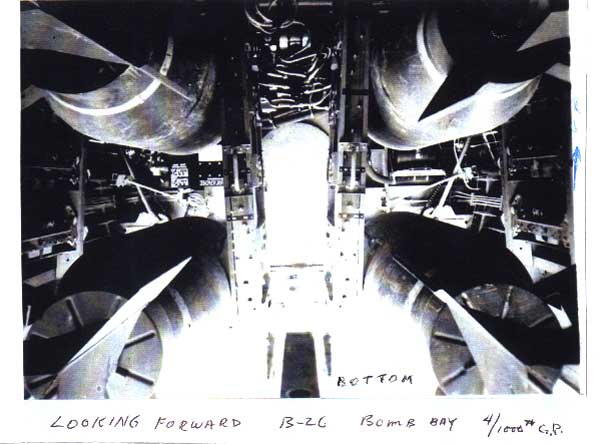
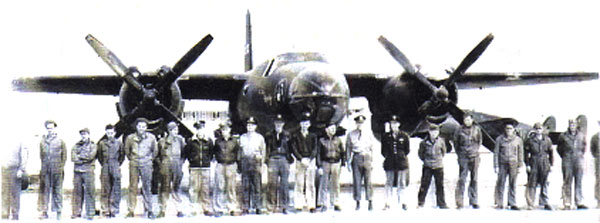
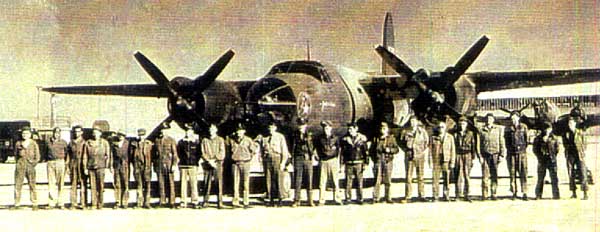
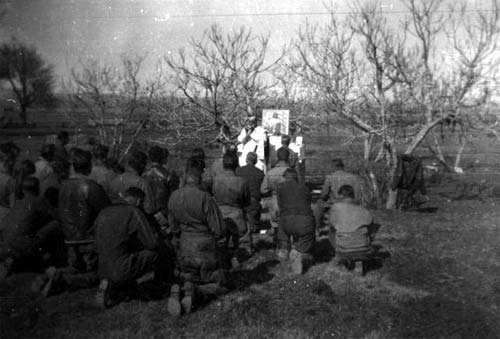
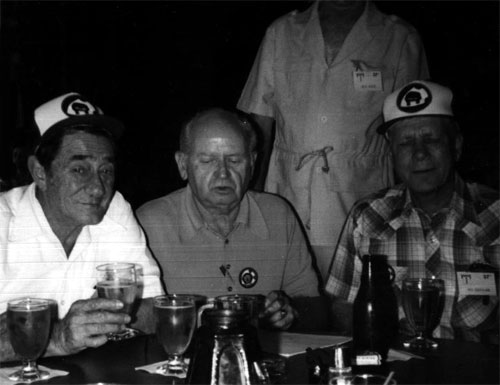
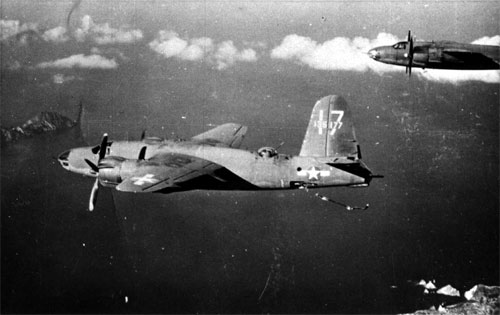
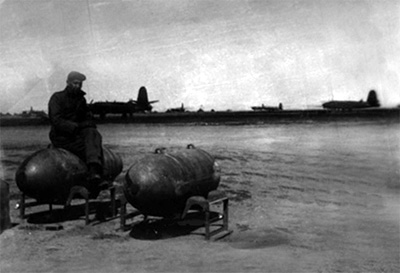
'Slim' Knowles - Armorer
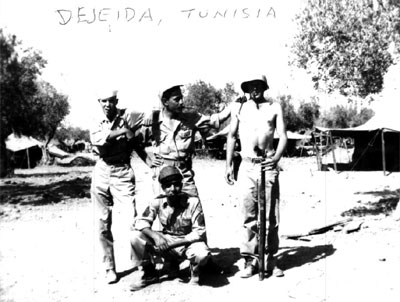
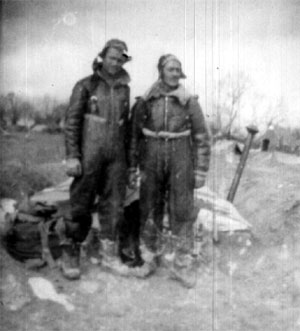
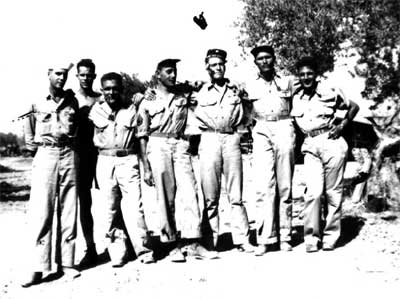
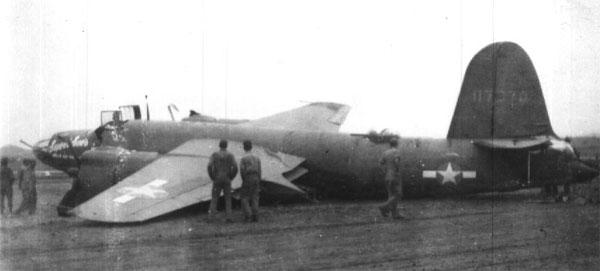
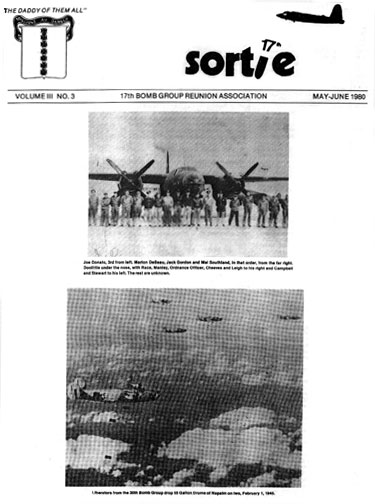
How we almost set the harbor at Tunis on Fire
by Joe Donato, 17th BG, 37th BS
March 12, 1943 was moving day for Ben Dodds and myself. We were vacating our half below,
half above ground two-man but that had shelter halves for a cover.
Six-man pyramidal tents were being issued to the 37th combat crews, This was a much batter situation for us. A whole crew would be under one roof, above ground and dry, with more room for each man and the convenience of a homemade stove to cook our eggs on.
The 17th Bomb Group had been at muddy Telergma for some time. The field site was located on a smooth plain between a range of low mountains near the small town of Telergms, about 30 miles from the ancient city of Constantine. Our targets had been Axis bridges, airfields and shipping. And while the enemy had been hurt, it was not done without losses to us.
On Feb. 24 the 37th lost 3 of the 6 planes k sent out with group in a raid on Alouina airfield outside of Tunis.
The end of February saw Rommel pushed back from the Kasserine area where his armor was only a few hours away from our field. Our crews were becoming more professional under such pressure. And for relaxation we had found the city of Constantine and the hot mineral baths at Sidi Athmenia
Late in the afternoon of the 12th the call came out that the next day's mission schedules were being posted, something eagerly watched since that would tell which crews would be flying as the sun came up.
My name was posted, which wasn't unusual. But this time one crew, the one 1 was scheduled to go with, had been set aside, separate from the other crews, on the bottom of the page. The order stated this crew will fly aircraft 11970, 10:30 takeoff time, X mission.
The crew was listed as follows:
Pilot - Lt. Boone
Co-Pilot - Lt. Cheeves
Navigator/Bombardier - Lt. Leigh
Engineer - S/Sgt. Southland Radio
Operator - Sgt. Donate
Ordnance - S/Sgt. DeBeau
Aircraft Crew Chief - Sgt. Larsen
"X mission," what the hell was that? And bringing a crew chief along too!
After chow and most of that evening we tried to figure out what an "X" mission would be. No one seemed to know. So after much speculation between ourselves we ate our snack of fried eggs and went to sleep.
March 13, morning was snappy and clear. We ate early breakfast, and went out to ship 6970, which showed a pygmy African warrior blowing & dart gun painted on its nose with the bettering "A Shade Raunchy" - just a shade.
We pulled the usual pre-flight checks with its ground crew, but our cargo caused even more speculation. We carried no bomb load. Instead, several large wooden boxes and half a dozen 20 foot lengths of 1-inch galvanized water pipe were loaded on board and fitted into the bomb bays.
Only Lt. Boone had been briefed. When he came out to the ship about 10 a.m., he only smiled when we inquired what was up? He kept tapping an envelope with his fingers and said we have sealed orders. We would all know as soon as we were airborne, he said. So we shrugged off the uncertainty, ran the props through, taxied out, and took off. In the air, we circled the field once, while Lt. Boone opened the orders ceremoniously. He announced we were to go to the French airfield a Biskra, about 150 miles south of Telergma There we were to "proceed as instructed."
The flight to Biskra took about an hour. We flew over the rough back of the Atlas mountains with peaks 6,000 feet high and rugged, rocky valleys below. We passed over then at 9,000 feet. As we started to descend for our approach, I could see a camel caravan plodding along a trail In the foothills. Then the desert came into view. We made an easy approach to Biskra. The airfield, about 2 miles from town was just flat hard ground without benefit of a tower. We landed on a well marked-up strip, taxied over to a small metal hangar that could have been a relic of World War 1. It had "Aerodrome dl Biskra" In weathered letters over the front entry.
As we exited the ship a squad of French soldiers stood at attention for us - a gesture of recognition we hadn't expected. And we were greeted by an ordnance detachment of about 12 men commanded by a Capt. Race. Also on hand were 2 full colonels to add Importance to our mission. They were observers. The first, Cal. Campbell was an Air Force officer, a personal representative of President Roosevelt, we later learned. The second, Col. Stuart was an Infantry officer and a West Point man. After Introductions we secure! the ship and French soldiers were parted to guard it. And it was only then 1 realized that routine and "raunchy" elf 970 now had a glamorous Norden eight on board.
We were taken into town - but not for easy living. We were set up in a rusty place, the ancient hotel Transatlantique In the center of town, a flea-bag with a fancy name. Each of us was issued a mattress cover, straw to fill it, and 2 blankets. The full crew was set up in one oversize room on the ground floor. This was to be home for our stay here, however long that would be. There was also a 6-man R.A.F. maintenance crew from a Beaufighter squadron stranded here. They had a couple of equally rusty smaller rooms. The Englishmen and ourselves filled the hotel up.
Our first job came that afternoon when we went back to the field to help Crew Chief Larsen put some plugs In the air scoops so that blowing sand would not get into the air intakes.
Biskra airfield had been used earlier by the Germans and by U.S. P-38's. But now all that remained were a few old French twin engine bombers that had escaped from the German occupation of France. There also was a large twin engine b4-plane that at one time had been at a Paris airfield. It must have been at least 20 years old and had some Rube Goldberg contraptions to keep It airborne. The whole flying picture seemed more linked to the past than the future.
The next morning we were picked up at the Transatlantique by a weapons carrier and brought to the airfield to start work on our mysterious mission.
And it was surprising. Our job, we learned, was to air drop homemade "gas and rubber bombs," something none of us had eve seen before.
Capt. Race and his men were working on a highly flammable device. This consisted of a 50 gallon gas drum that was half filled with chips of rubber hacked off of a large block of crude rubber with machetes. The balance of the drum was then dropped off with gasoline. This mixture would set overnight and become a jellylike mass in the drum.
Some drums had fins welded on the ends for stability. Some had no fins but a long contact fuse into the drum to aid ignition. Others had an incendiary bomb screwed into a flange that had been tack wielded to the drum end.
The drums had two one-half inch wire rope cables spaced to receive our bomb shackles. These were secured by locking clamp bolts. We were told that a 8-25 had been tested to drop the drums, but its bomb bay doors were too narrow to accept the drum. So a B-26 - ours - was requested to replace the B-25.
Hence we came to Biskra on an "X mission." The bombs were completely experimental. Col. Campbell felt that they would be very effective against shipping, specifically In the Axis supply port of Tunis. The small Sieble ferries the Germans used would be especially vulnerable to fire.
The experimenters were anxious for us to drop the first two drums that were now ready. While they were being loaded into the bomb bay we could see that the homemade contraptions barely cleared the bomb bay doors. This caused much anxiety to the air crew, to say the least. A wedged drum could ignite the plane.
It was a very concealed crew that took off with the first two bombs from Biskra.
Lt. Leigh had no bombing tables for this configuration. They were to be dropped from about 300 feet Into a small take a few miles away. Leigh was interested in the trajectory. Race wanted to know how they would react on contact with a water surface.
The first ore hit with a thud - a dud. The second one went off with a flash and blobs of burning jelly went flying in all directions while the bomb case burned fiercely on the water surface
The next few days we dropped at least a dozen. Some were duds. Some were real infernos.
On one flight, for some reason, we had a delayed drop and the bomb hit the desert floor Instead of the lake. When it hit, the bomb went off and left a spectacular trail of fire as it skidded along the ground.
On one occasion I went to the drop site with Capt. Race as observer and to photograph the hit. We had a K-20 camera with us. But we had a dual abort. The bombs came down with a swooshing, rushing noise and just plunked Into the water. The camera jammed. So we got neither photos nor fire. Later, when we cleared it, all I got was a picture of Capt. Race in the jeep we had come to the lake in.
On about the fifth day of trials, we blew a booster coil in our right engine as we were taxing for takeoff. We had no replacement parts with us, so it was decided to see if one of the French bombers would ferry Lt. Boone and Sgt. Larsen back to Telergma to pick up a replacement part. The French C.O. was agreeable. A French medium bomber took off with Boone and Larson for Telergma. I tried to get on, too. But the French pilot, a veteran of 2,000 hours waved me off. He said the plane was now full.
I went back in some disappointment to our ship. Because Mal Southland said he wanted to change the plugs in the right engine; maybe he would need some help. I could speak some Italian so he sent me over to the French hangar to see if they had some spark plug grease. Somehow the French mechanics understood my Italian -- and we got the grease.
By now 3 hours had passed and the French bomber was overdue on the return flight from Telegma When six hours had passed we all became concerned, including the French C.O.
There was a small operations building on the field so I was sent over to see If I could raise Telergma, somehow, to find out what was happening.
There was only a telephone and a reluctant French noncom do the office. He finally agreed to call Constantine. The code name for Constantine was "nutmeg". The call was transferred to Telergma post office and then somehow to 37th operations from where a 37th voice said that no French bomber had arrived as yet from Biskra. We then got cut off.
The French bomber from Bistra never reached Telargma. It had crashed near Batna with no survivors. A close call for me, a sad accident for our crew mates.
The next day a 37th squadron 8-28 landed at Biskra piloted by a disturbed Major Bowen, our C.O. He brought in a pilot replacement, Lt. Manley, and a Crew Chief replacement, Sgt. Jack Gordon. With a full crew we continued to make drops into the take - some duds, some real live ones.
One day as we were taking off for a drop, we saw a B-26 preparing to land. When we got back we found eminent visitors. Gen. Jimmy Doolittle had arrived to see what progress was being made on the trials. A special nay was made for him. He watched from near tire drop area. Both bombs just plunked Into the lake. Duds.
However, Doolittle expressed confidence in the bomb and said, encouragingly, that h would only be a question of time before a reliable fire bomb would be perfected. Fig than deported and left us to go back to the tests.
We must have dropped about 30 of there bombs with about a 50 percent detonation rate over the course of about 13 days.
And then the way we came, we departed. An order WOW up on the board. We packed our Night bags. But two comrades had been lost in that trial time.
Before we left we were Instructed not to discuss our doings at Biskra with anyone. When we arrived at Telwgma i was told my close friend Fred Clive was K.I.A. on March 22. It happened on a sea sweep. An Italian fighter made one fatal pass and the B-25 fell Into the sea near Sicily.
Ben Dodds had fared better. His shot up ship bellied in near Bone. The crew walked away from it but Ben was badly shaken up by it, to say the least.
In May of 1943 - only weeks after our Biskra tests - the African campaign came to an end with the defeat of the Axis African armies. I had kept a meager diary during the Biskra affair and soon after the war ended I started to put together some order of the events as they occurred using the diary and pictures that were taken at Biskra.
Then the notes took a long slumber. In 19721 tried to locate Capt. Race and others with no success. Then I decided to writs to retired General James Doolittle to ask if he could enlighten me as to the final outcome of the Biskra trials. The attached letter was his reply.
At the Dayton and Colorado Springs reunions of the 17th Group I met Mel Southland and Jack Gordon where we further discussed the events at Biskra.
We never did find out the outcome of our gas and oil bombs. But, recently, while looking through a copy of "The Log of The Liberators," low and behold, there was a picture of a formation of B-24's of the 819th Squadron 30th Bomb Group dropping 55-gallon drums - of what was by then called NAPALM - on Iwo Jim on Feb. 1, 1945. So it would appear that our fickle contraptions in the African campaign were finally perfected and used in combat two years later in the far Pacific war.
How the 17th Won the war!
by Joe Donato
We landed in Casablanca, French Moracoo in the North Africa on December 24, 1942, late in the day. We filed of the Susan B. Anthony, the ship that we crossed over in with a large convoy. A 13 day trip across the Atlantic Ocean during the hieght of German submarine warfare without any loss to our convoyby enemy action! Some up stairs was really watching over us.
Late in the day we filed off the ship after we filled our canteens with water and were issued 3 packs of "K" rations as well as a bandolier of ammo for our rifles.
From the piers we marched all night until about midnight, stopping twice along the way to eat and est our feet. We camped in a field and slept until the Sun rose on Christmas Day. As the day started local Arabs came around and just stood and watched us. Then a jeep pulled up and a Chaplain jumped out, he unloaded a bale of hay for a alter so he could say Christmas services for all who wanted to attend.
Later that same day, we were marched to a nearby hanger at Cozeo airfield. The condition of the hanger was a mess, with junk all over. We cleaned an area and would sleep on the floor on our shelter halves with a blanket over us. At this time we had not taken a shower or removed our clothes for at least 15 days since Stateside.
By New Years eve we were still sleeping in the hanger and on midnight New Year's day, the air raid sirens went off, a German long range bomber dropped 3 bombs nearby. Lucky there were no casualties. The following day, Jan 1 1943 was my 23rd birthday. Also we found out our President, Franklin Delano Roosevelt and Prime Minister Winston Churchill were holding a conference in Casablaca.
Their motorcade with a heavy momotor cycle escort passed by us as we were rolling 50 gallon drums of gas to a gas dump. We waved to him and Churchill and they both waved back!
After New Years day, we were relocated to an open air stadium, 2 men to a tent, Ben Dobbs and I pooled out shelter halves to make a pup tent to call out home. Soon after we decided to expand our "living quarters" we had noticed large plywood boxes that P-40 belly tanks had been shipped in from the U.S. to Cazeo airfield nearby. Ben and I noticed some empty crates set off to a side. So that night after it got dark, we moseyed over to the air field and picked one up, and carried it back to our tent, we did this without being detected. We were elated, we could vision a roomier home, the box with a shelter halve top!
But we had a slight problem, we then noticed all the screws holding the top on were in place! The box had not yet been opened and there still was a belly tank inside. We took the box back where we "found" it at once.
The next night we tried again. This time we made sure the box was empty. How dumb could we have been? No trouble at all to be this way.
A Double Whammy by the 17th BG, September 17, 1943, Part 1
by Joe Donato
The middle of Sept. '43 was touch and go for our GIs at Salerno, Italy.
The Germans where on high ground all around the landing beaches at Salerno pounding our forces as they landed on the beaches along the Amalfi Drive. One of our landing points was Miori, my mother-in-laws birthplace before she came to the U.S. in the early 1920's.
On the Sept 17 '43, the 17th BG, was briefed on a target, Practica di mare airfield, about 20 miles south of Rome. Where a large number of German transports where in the process of landing. Each transport was towing a glider, loaded with German troops to add to the German forces at the Salerno beach head.
Intelligence had alerted our airforces in North Africa to this target while the Germans were still airborne.
The 17th made landfall east of the target area. We made our run through heavy flak, our bombs covered a large part of the dispersal area and our frags were very effective against this type of target.
Today I flew tail position instead of the waist which was my regular position. The tail position would give you a good view of the target area as we left it. I could see considerable destruction to our targets on the ground. Soon we were back over the water, heading for A.P.O. 520 at Djedieda and ready for the regular after mission interrogation.
Double Whammy Part 2, Sept 18, 1943
by Joe Donato
I was scheduled again for today's target. When our pilot came back from briefing he told the enlisted crew that out target for this mission would be a place called Practica di Mare near Rome! The pilot was not on the mission there the day before.
I began to smell the cordite from the 88's before we took off. We used the same flight plan as the day before. As we started our bomb run I could see a lot of wrecks on the ground. This time we were given a early greeting by the 88s. And it was intense and accurate. A box barrage tight over the target and on our altitude. We could hear the woomph of the shell bursts and smell the corite as we passed through them - this was a time for a lot of praying! There was also some burst of a red flak we had never seen before. It didn't seem possible our group could pass through this barrage without a loss. As we left the target area we could still see the 88s twinkling at us from the ground saying "good bye, but we'll get you next time."
During the next few days I think all of the mediums in the 12th Air Force paid a visit to this target.
The next mission for me, on the 20th of September, was to the road junction at Formia. No flak, no fighters, a milk run.
The Saga of Pantelleria - The first piece of Europe to be occupied by the
Allies.
by Joe Donato
May 18, 1943
For almost a month now, the North-West African Air Forces were giving the Italian Island of Pantelleria regular attention. This Island was about midway between Tunis and Sicily. On this date the 17th BG hit the one airfield on the Island with 500 pound demo bombs. We added more wrecks to the already number of planes there there that had suffered previous raids on this airfield. I could see a bomb trail one quarter way across the Island, as the whole Island was only about 4 miles wide at this point. Smoke and dust from our bombs obscured the target right after our bombs hit the airfield. To add to this, the enemy had put up a smoke screen - this didn't help our view from above any.
We saw no motion or activity on the ground before the bombs hit. While Pantelleria seemed close to the African mainland, it still was a 3 hour and forty minute trip for our round trip from Sedrata.
June 7, '43
Pantellaria on this day Pantillaria was our target. As usual we were at our designated ship early to check over and Pre-Flight it. When our pilot came from target briefing, he then briefed the enlisted crew. After we were briefed on the target, we ran the props through and boarded, prepared to take off. As we were on our takeoff run, the pilot cut the engines. He couldn't get enough fuel pressure reading on the instrument. He tried a second take off with the same lack of pressure. This pilot had been instructor pilot back in the States before his transfer overseas to our Squadron. He aborted the mission.
The rest of the groups target was the airfield on Pantelleria - with us, of course the crew got no credit for a mission.
Well, some you win and some you lose.
June 9, '43
We went to Pantillaria again today. Our targets were the coastal guns on the Island. These guns could cover any seaborne assault on the Island. This time our bomb load was 1000 lbs. bombs with some on delayed fuse to be more effective against the concrete revetments that housed the big guns.
There was light flak as we dropped our bombs on the target. There was no sign of life or movement on this tiny Island as we left the target area, some more flak was shot up at where we had been. Back at Sedrata, during our interrogation, the consensus was that there were fewer coastal guns in operation after this mission. This was another dull interrogation upon landing. There just wasn't anything different from last mission over Pantellerian to report.
June 11, 1943 "D-Day for Pantelleria."
After the usual pre-flight checks, and our pilot George Jackson briefed the crew, we now know that an invasion fleet was on its was to Pantelleria and would make landings there this day. The 17th was the first group over the Island today. For some reason we had a P-40 escort today. There was very light flak from below. We were after a target of opportunity if we could find one. All we could see was bomb craters all over the island. Somehow we did hit a small gas dump on the edge of the island, black smoke came up to our altitude of 9000 ft. almost at once.
We had been about 30 minutes ahead of our landing forces as per schedule. We could see the invasion fleet as we were leaving the island. Pantelleria, surrendered with no opposition. When we landed at Sedrata, the crews attended the shortest interrogation ever, there was so little to report, shortly after the fall of Pantelleria, I read in the "Stars and Stripes", the only casualty was one soldier in the landing force - he had been bitten by a wild donkey.
This was the first piece of European land to be taken and held by the Allies for the duration of the War.
Joe Donato, 37th BG
October 5, 2002
"A Early Morning Sea Sweep"
On May 6, 1943, 37th flight crews were awakened by Jimmy Stivers, our operations clerk at 2 a.m. for a early morning mission.
Operations had received a call from our intelligence that German sieble ferries were leaving the harbor of Tunis, and were presumed to be headed for Sicily.
We ate an early breakfast, and went out to our assigned planes. The crew chief was already there, and preparing the ship for take off. Armament crews were loading the bombs. When George Jackson, our pilot, came back from briefing of our target, with the other officers on our crew, we were to go out on a sea sweep, between Tunis and Sicily.
The 17th group was assigned to search a grid area between Catania, Sicily, and Tunis.
We took off from Telegram, our base, formed up into a formation, and headed out to the sea, and started to patrol our assigned grid area. By now the first light of the day was on us.
We were not on patrol for more than half an hour when George Jackson called the crew and alerted us that a target had been sighted. He then remarked "I guess we'll be going back to A.P.O. 520 sooner than we expected.
As we started our bomb run, I could see 12 Sieble Ferries, the Siebles broke their formation, and separated from each other in groups of three, then they started evasive action to give our bombardiers a a harder target.
We made two runs on our targets, each time one half of our bomb load.
We bombed from 12,000 feet.
As the Germans sent up a carpet barrage that topped out at about 10,000 feet. From the waist gun position I saw two boats get direct hits, and a third boat dead in the water, no motion at all. We then headed back to A.P.O. 520.
When we landed trucks came out to our planes to bring to bring the crews to interrogation at the intelligence tent.
At the entrance to the intelligence tent the red cross ladies had set up a coffee stand, we each got a cup of coffee, and a donut. We were asked Questions about the mission, and did we see anything different or unusual. We were then dismissed.
My father goes on about how he had tried to get more info on the sieble ferries.
Would anybody with info or a recollection of any missions or anyone who would like to correspond, please feel free to contact me.
Thank you,
Joe Donato Jr.